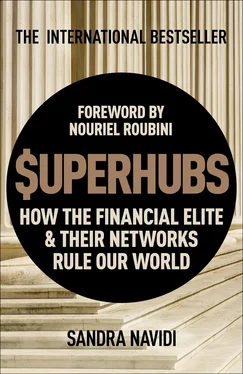Sandra Navidi - SuperHubs - How the Financial Elite and Their Networks Rule our World
Здесь есть возможность читать онлайн «Sandra Navidi - SuperHubs - How the Financial Elite and Their Networks Rule our World» весь текст электронной книги совершенно бесплатно (целиком полную версию без сокращений). В некоторых случаях можно слушать аудио, скачать через торрент в формате fb2 и присутствует краткое содержание. Год выпуска: 2017, Издательство: Hodder & Stoughton, Жанр: Старинная литература, на английском языке. Описание произведения, (предисловие) а так же отзывы посетителей доступны на портале библиотеки ЛибКат.
- Название:SuperHubs: How the Financial Elite and Their Networks Rule our World
- Автор:
- Издательство:Hodder & Stoughton
- Жанр:
- Год:2017
- ISBN:нет данных
- Рейтинг книги:4 / 5. Голосов: 1
-
Избранное:Добавить в избранное
- Отзывы:
-
Ваша оценка:
- 80
- 1
- 2
- 3
- 4
- 5
SuperHubs: How the Financial Elite and Their Networks Rule our World: краткое содержание, описание и аннотация
Предлагаем к чтению аннотацию, описание, краткое содержание или предисловие (зависит от того, что написал сам автор книги «SuperHubs: How the Financial Elite and Their Networks Rule our World»). Если вы не нашли необходимую информацию о книге — напишите в комментариях, мы постараемся отыскать её.
SuperHubs: How the Financial Elite and Their Networks Rule our World — читать онлайн бесплатно полную книгу (весь текст) целиком
Ниже представлен текст книги, разбитый по страницам. Система сохранения места последней прочитанной страницы, позволяет с удобством читать онлайн бесплатно книгу «SuperHubs: How the Financial Elite and Their Networks Rule our World», без необходимости каждый раз заново искать на чём Вы остановились. Поставьте закладку, и сможете в любой момент перейти на страницу, на которой закончили чтение.
Интервал:
Закладка:
One of the newer and most prestigious addresses is the sparkly 15 Central Park West. The “tower of power” is located on the southwest corner of Central Park. Of modern and effortless elegance, it is the epitome of extravagance. It contains a seventy-five-foot sky-lit lap pool, a private restaurant, a wine cellar, a gym, and a screening room. The staff is highly trained and renders top service for top dollar, as monthly maintenance alone typically runs in the thousands. Many of the apartments are equipped with private elevators, spectacular terraces, and floor-to-ceiling windows that allow for sweeping views of Manhattan. One-bedroom apartments are available to accommodate the residents’ staff. The building has counted former Citigroup CEO Sandy Weill, CEO of Goldman Sachs Lloyd Blankfein, and hedge fund billionaire Daniel Loeb amongst its residents.
Townhouses on the Upper East Side of Manhattan are also popular with the billionaire crowd. They come with a backyard, which is the ultimate luxury in a city where space is such a finite commodity. Leon Black recently bought a $50 million townhouse in the tony neighborhood that requires another $20 million in renovations. It will serve as the perfect backdrop to Black’s spectacular art collection, which comprises many masterpieces worth hundreds of millions of dollars.
On summer weekends, the power scene moves either to the Hamptons on Long Island or “to the country,” lingo for north of the city. Virtually all financiers own McMansions, equipped with pools, tennis courts, and guesthouses, surrounded by lush formal gardens, tall privet hedges, and security features. The upkeep costs hundreds of thousands of dollars a year and often requires the employ of an estate manager. Even within clusters, supernuclei form. In the Hamptons, superhubs congregate around Meadow Lane, Gin Lane, and Dune Road. Leon Black owns a massive beachfront compound where he celebrated his sixty-third birthday with a spectacular private Elton John concert. Financiers David Ganek and Henry Kravis also reside in the neighborhood. Steve Schwarzman acquired a property in Water Mill that once belonged to an heir to the Vanderbilt fortune, and rebuilt the estate.
Luxurious weekend homes also serve as the perfect sites for entertaining and hosting glamorous parties, another way that the financial elite remain within their own social circles.
Every year on the Fourth of July, Lally Weymouth, the Washington Post heiress and author, hosts an elegant reception followed by a formal sit-down dinner at her classic Southampton estate. I had heard much about her annual gathering, one of the social highlights of the summer for the rich and famous. Invitations are highly coveted, and all the titans of finance and their glamorous wives are eager to attend: Steve Schwarz-man belongs to that circle, as does Lloyd Blankfein, Leon Black, Henry Kravis, and Wilbur Ross. Outsiders are accepted as long as they bring something interesting, entertaining, or useful to the table. I was thrilled to be invited but was unsure about the decorum: what dress to wear, what kind of present to bring, and what to expect.
* * *
Chapter 5 has delved into the preeminent forces that empower the financial elite and make it so homogeneous: homophily —or the “love of being alike”—and the “rich-get-richer” phenomenon. Now that we have a clear sense of how homophily operates within the circles of the financial elite, Chapter 6 will explore exactly how these executives build networks to further their power.
CHAPTER 6
Executive Networking
Relational Capital
THE SUPERHUB Of SUPERHUBS: KLAUS SCHWAB
Located in the French part of Switzerland, Geneva is a match for its French neighbor in terms of style and elegance. It has a quaint charm coupled with understated glamour. Majestic mansions and manicured gardens with a touch of patina have borne witness to its history as an exclusive and discreet enclave for the rich and their fortunes. Against the backdrop of the massive snow-covered Alps, life here appears deceptively serene, but it is like a swan on Lake Geneva—quiet on top, but paddling vigorously underneath. Many big and influential institutions are headquartered in Geneva, such as the World Health Organization (WHO), the European Organization for Nuclear Research (CERN), and the World Economic Forum (WEF). The WEF is most commonly associated with the Swiss ski resort of Davos, because of its renowned annual gathering, but the institution’s headquarters are located in an exclusive municipality of Geneva called Cologny.
During one of my frequent business trips to Switzerland, I accepted an invitation to visit the WEF. A taxi ferried me across Lake Geneva to the Left Bank and up the hills along the old parts of town. As I took in the pretty view of the mountains and traveled the winding road lined with greenery and colorful blossoming flowers stretching toward the sun, it felt more like a vacation than a business trip to one of the world’s most powerful institutions. The taxi eventually made a left turn and approached a heavy metal sliding gate. After passing the high-security clearance, the gate opened automatically and a sweeping circular driveway led to an ultramodern concrete-and-glass building. I made my way to the reception desk, where I ran into a couple of familiar faces and was led to a conference room. The architecture reflects the uniqueness of the institution it houses. A mix of Eastern and Western elements, it features an open design with glass walls offering magnificent views of Lake Geneva. A lively cosmopolitan mix of predominantly younger people dressed in business casual outfits congregated in the spacious and sun-drenched public areas, which are decorated with eclectic art from all over the world.
The WEF is one of the least understood and most controversial organizations in the world. Its mystique may result from the fact that it is the creation of only one person, and doesn’t seem to neatly fit into any box. Even though the Forum was originally focused on economic issues, it now embraces a holistic approach that includes science, politics, and culture. It is perhaps the most effective and powerful network platform and incubator of our time. Like a giant think tank, it focuses on pressing issues and provides a framework for solutions, often by joining or brokering public-private partnerships. The convocation of power players in Davos has suffered criticism for undue collusion, but global problems require global solutions, and the WEF is uniquely positioned to bring together an eclectic mix of influencers. The WEF’s status was significantly elevated in early 2015, when the Swiss Federal Council recognized it as an international institution for public-private cooperation similar to that of the Red Cross.
One of the greatest network creators is the WEF’s founder, Klaus Schwab. How did an academic, from his start as a young economist and engineer, manage to attract the world’s most influential people and establish the preeminent international interdisciplinary meeting platform? The bald, bespectacled, and earnest German professor speaks slowly in a baritone voice with a thick German accent. With his straight gait and head held high, he has the demeanor of a statesman, and by virtue of his superhub position, he is as powerful as many of his guests. Surprisingly, by his own account, he is an introvert and shuns the party circuit. Some mistake his shyness for arrogance. He may seem reserved, but his wide and deep network is a testament to his thoughtfulness and sincerity. He is known for his discipline, affinity for strenuous mountain hikes, and dry sense of humor.
Schwab established the forum in 1971 as a modest gathering of European business executives. With vision, intuition, a curious mind, and laser-sharp focus, he developed the Forum into an exclusive global brand. Now in his seventies, he is still the driving force of the organization and a continuous source of innovation. Critics—mostly those who have never been invited—perennially predict Davos’s demise, and attendees complain about everything from the logistics to the fees. Yet they all return year after year, and the demand for tickets far exceeds available spots.
Читать дальшеИнтервал:
Закладка:
Похожие книги на «SuperHubs: How the Financial Elite and Their Networks Rule our World»
Представляем Вашему вниманию похожие книги на «SuperHubs: How the Financial Elite and Their Networks Rule our World» списком для выбора. Мы отобрали схожую по названию и смыслу литературу в надежде предоставить читателям больше вариантов отыскать новые, интересные, ещё непрочитанные произведения.
Обсуждение, отзывы о книге «SuperHubs: How the Financial Elite and Their Networks Rule our World» и просто собственные мнения читателей. Оставьте ваши комментарии, напишите, что Вы думаете о произведении, его смысле или главных героях. Укажите что конкретно понравилось, а что нет, и почему Вы так считаете.












